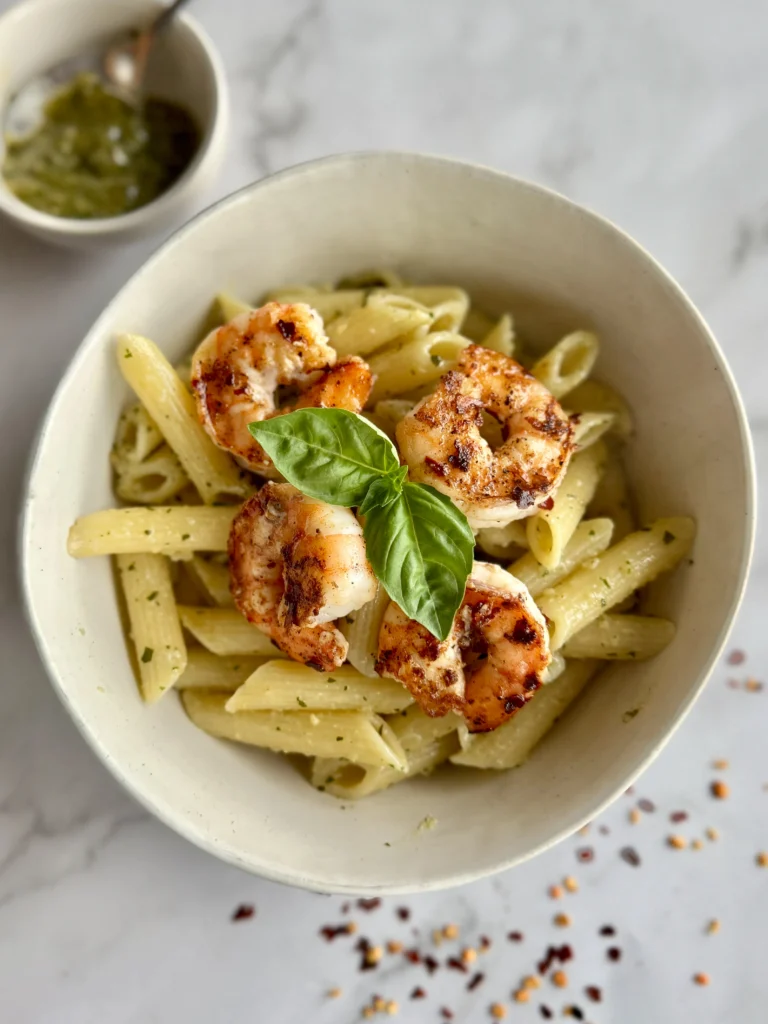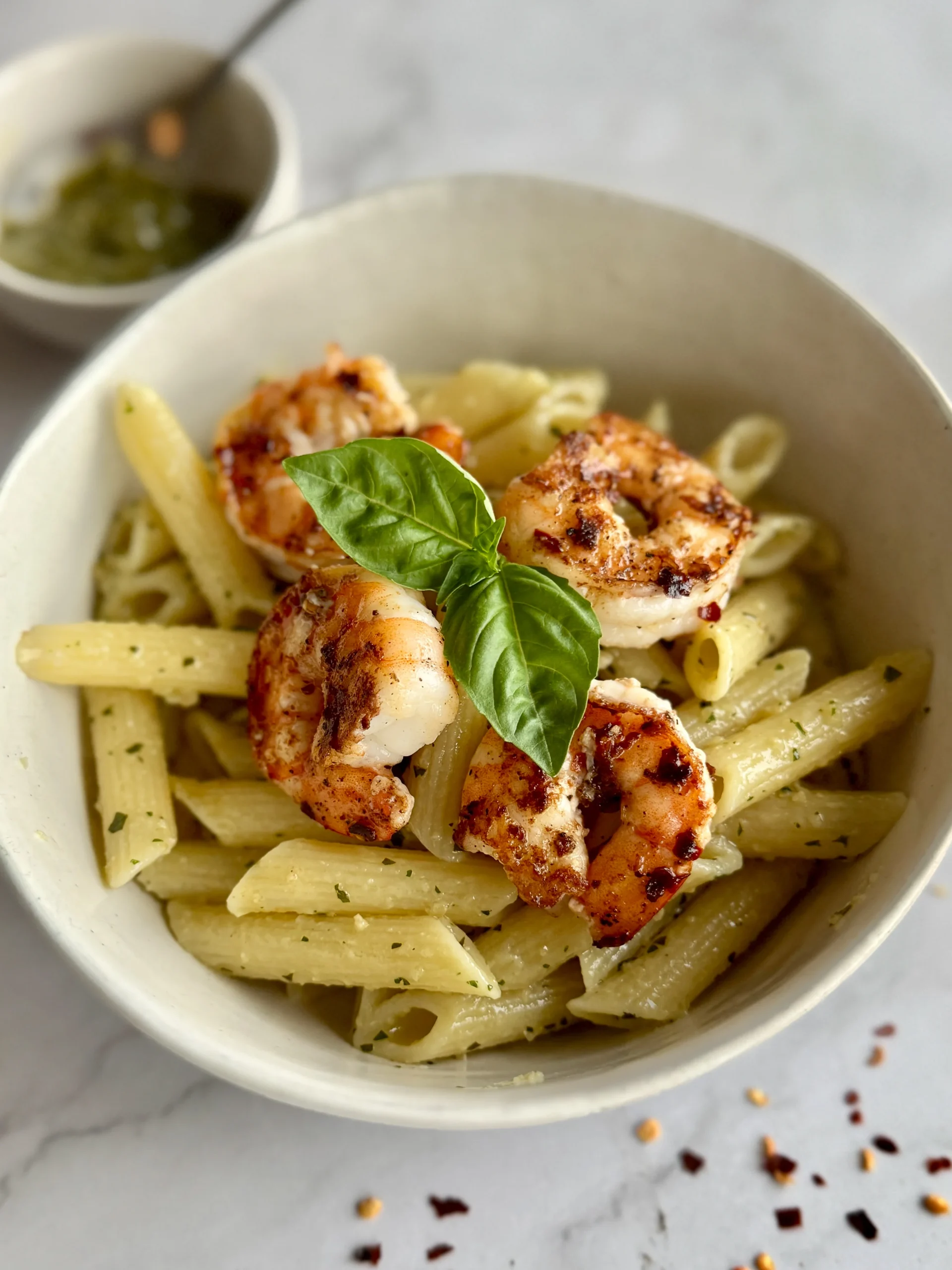This Shrimp Pesto Pasta recipe is one of those meals I forget exists because it’s almost too easy. In under 20 minutes you can have a delicious, impressive pasta dish on the table. It’s even tasty cold as a pasta salad! Using store-bought or previously made homemade pesto makes this recipe a breeze.

I created this recipe when I realized that I had way too much pesto in my freezer. At the end of each summer I make a bulk batch of pesto and freeze it for the year so I always have a ton on hand. This enables me to make shrimp pesto pasta throughout the year when we have no fresh basil.
Why You’ll Love This Recipe:
- Quick and Easy: Using either store-bought or pre-made pesto (I keep extra in the freezer) makes this recipe a breeze!
- High Protein: Shrimp is low in calories and high in protein – meaning you can eat a ton of it!
- Shrimp is Fast to Cook: Shrimp thaws quickly in water and cooks in under 4 minutes (though this is size dependent). No marinating necessary.
- Dairy-Free Option: If you’re unable to have dairy, use a dairy-free pesto! The richness of the nuts, basil, and olive oil will still offer incredible flavour to this dish.
Ingredients Needed for Shrimp Pesto Pasta:
This recipe as written serves 4, but I intially made this only to serve 2 (as evidenced by shrimp photos) with extra pasta for my husband’s lunch. It’s easy to adjust the amounts of shrimp or pasta according to appetites and preferences. This shrimp pesto pasta recipe is easy to double or half.
- Dry Pasta: My preference is to use penne, rotini, bows, or rotini, but you can use any shape you have on hand. Pesto adheres well to any pasta shape so anything you have will work.
- Salt: Salt your water when you boil your pasta. It should taste like the ocean. If you don’t use enough salt you may need to add more salt at the end.
- Pesto: Store-bought is great here! I make a big batch of pesto at the end of summer and freeze it to have on hand for quick dinners like this one. Dairy-free or regular pesto will work.
- Shrimp: My favourite size to buy is 25-30, deveined but with the tail still on. You have to remove the tail yourself but it’s relatively quick to do. Any size is fine – just adjust cook time.
- Butter: Feel free to use olive oil, but I find the butter makes the shrimp extra tender.
- Black Pepper: Please use freshly ground.
- Red Pepper Flakes: Use as little or as much as you like. As the recipe is written it is not spicy.
For Best Results:
- Use higher quality pasta: The white dusty looking pasta at the store has been dried slowly and traditionally while yellow types typically were dried quickly. I find the whiter and higher quality pastas hold their texture better after cooking and don’t get mushy in the fridge.
- Cook pasta to al dente: Meaning, your pasta still has some bite but is cooked through. This is entirely up to your preference though.
- Don’t overcook the shrimp: Once the tail has fully curled in and the “spine” is no longer glossy but opaque, remove from the heat.
- Cook shrimp from thawed (or fresh)– not frozen: Frozen shrimp when cooked comes out tough and chewy since it takes so much longer to cook. The outside will be overcooked while the inside just finished.
- Salt: Salt your water. Salt your shrimp. Salt your pesto before adding to the pasta if needed (especially for homemade). By salting at each stage, you will actually use LESS salt overall and improve the flavour of each ingredient.
Using Frozen Pesto & Freezing Instructions
To use frozen pesto, you just have to leave it in a bowl on the counter for 15-20 minutes and it’s ready to use! Alternatively you can microwave it for 15-20 seconds (but be careful not to cook it).
Freezing pesto is easy! If you ever buy one of those large costco jars and don’t want to waste it – try freezing it. Line a baking sheet with parchment paper or tinfoil and spread the pesto until it’s 1/4 inch thick. Place it uncovered in the freezer for 24 hours. Once it’s frozen – cut it into pieces with a butter knife or break it up by hand into a resealable bag or container. Work quickly because the oils will melt fast!
What Type of Pasta to Use?
You can use any kind of noodle here! I would probably lean away from spaghetti or other thin noodles but the pesto should adhere to any pasta type.
Spiral noodles, wide noodles (fettuccine or tagliatelle), or any noodle with lots of grooves to hold onto the sauce would be best.
Using Frozen Shrimp: Thawing Frozen Shrimp Quickly
Never cook shrimp from frozen. Never ever. It will be so tough and chewy you’ll wonder if you even like shrimp.
Shrimp thaws exceptionally quick due to their size and surface area. Place in a medium bowl and cover with water. The more water to shrimp the better. You can use warm water to speed it up but never use hot (you will cook the shrimp).
Shrimp should thaw in 30 min – 1 hr in cool water with the water changed halfway through. Warm water should reduce this to 15 minutes if you change the water halfway through.
*SAFETY NOTE* If you thaw in warm water, cook immediately to prevent the growth of harmful bacteria. Place shrimp thawed in cold water back in the fridge until ready to cook.
Shrimp (Deveined vs Cooked vs Shelled)
- Deveined Shrimp: Technically the vein (aka digestive tract) is not be harmful if consumed. I still think it’s gross and buy them already removed. You can do this by hand by removing the shell/tail and using a small knife to cut along the back of the shrimp. Slide the vein out and discard.
- Cooked vs Raw Shrimp: You could buy your shrimp already cooked but why would you do that when it’s so quick to cook them? They’ll taste much better seasoned and seared at home. But not judging if you want to do that..
- Unshelled vs Shelled Shrimp: Depending on where you live you may encounter unshelled shrimp – this means the head, tail, and feet are still attached.
- Unshelled shrimp: Twist off the head and remove the shell (which contains the feet and tail). Cut along the back/spine of the shrimp until you reach the vein and remove it.
- Shelled shrimp: May either have a tail, tail and feet, or no tail remaining but will be deveined. Remove the tail and feet easily by pinching the underside of the shrimp to slide it off.
To Make Shrimp Pesto Pasta:
Start Cooking the Pasta
Bring a large pot of water to a boil, salt well (like the ocean), and cook the pasta to al dente. Never follow the package and instead, try a small piece to see if it’s cooked how you like it.
Cook the Shrimp
While the pasta is cooking, prep the shrimp (peel and devein if necessary) and pat it dry. Season with salt, black pepper, and red pepper flakes.
About 3-4 minutes before the pasta is cooked, preheat a skillet over medium heat. When ready to cook, add the butter and let it melt and foam before adding in the shrimp in a single layer.



*Please note these images are done with a half serving of shrimp – you will have much more!
Flip each shrimp once the tail begins to curl and it resembles the U shape (about 30s-1 min). Once flipped, cook until it fully curls in and the back of the shrimp is no longer translucent but opaque (~30 seconds). Careful not to overcook, it happens quickly!
Once they are cooked remove them from the heat into a separate dish.
To Serve
Drain the pasta and toss well with the pesto. Optionally add the shrimp to the pasta or leave it on the side. This easily allows people to choose how much shrimp they’d like while avoiding continuing to cook the shrimp.
Top with parmesan if desired and enjoy!
Looking for more Quick Dinner ideas?
- Quick and Hearty Minestrone Soup
- One-Pot Thai Coconut Chicken Curry
- Quick and Easy Black Bean Burrito Bowl
- Easy Red Lentil Curry | Masoor Dal

20-Minute Shrimp Pesto Pasta
Ingredients
Method
- Bring a large pot of water to a boil, salt well, and cook the pasta to al dente.
- While the pasta is cooking, prep the shrimp (peel and devein if necessary) and pat it dry. Season with salt, black pepper, and red pepper flakes.
- About 3-4 minutes before the pasta is cooked, preheat a skillet over medium heat. When ready to cook, add the butter and let it melt and foam before adding in the shrimp in a single layer.
- Flip each shrimp once the tail begins to curl and it resembles the U shape (about 30s-1 min). Once flipped, cook until it fully curls in and the back of the shrimp is no longer translucent but opaque (~30 seconds). Careful not to overcook, it happens quickly!
- Once they are cooked remove them from the heat into a separate dish.
- Drain the pasta and toss well with the pesto. Optionally add the shrimp to the pasta or leave it on the side. This easily allows people to choose how much shrimp they'd like while avoiding continuing to cook the shrimp.
- Top with parmesan if desired and enjoy!

[…] 20-Minute Shrimp Pesto Pasta […]